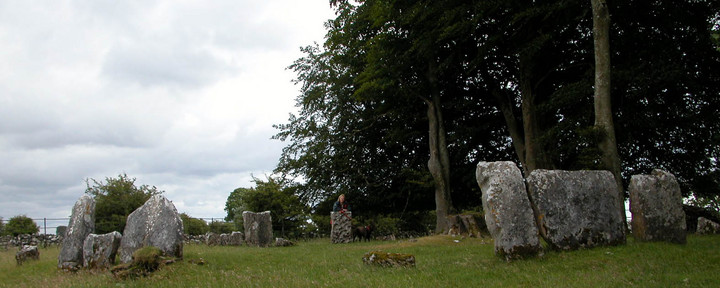
September 2016

September 2016

September 2016

September 2016

September 2016

September 2016

24/8/10

24/8/10





Looking towards the recumbent with its flankers

Visited 21.5.11
What a cracking stone circle this is! (The main circle that is)
The field in which the circle stands was full of cows that were too busy chewing the cud to be bothered by me. I hopped over the protective black metal fence and had the circle to myself.
The slightly raised ground the circle stands on plus the trees gives this a lovely setting – it also provided me with cover out of the rain to write my notes!
I counted 17 stones left in the circle with a stump of a stone just outside the circle. There were also 3 stones piled to one side – fallen stones from the circle?
In the centre of the circle is the remains of a cairn which was covered in grass with just the tops of some stones sticking out.
This is a great site to visit but access to the stone circles (other than the ‘main’ one) is difficult. Two however be clearly seen from the edge of the field which the ‘main’ circle stands in.
Cong is a small, historic town sited between the loughs Mask and Corrib, large bodies of water which restrict the approach to the mountains of Connemara from the east. Its principle claim to fame is the ruined 12th Century abbey, the building besieged by schoolboys as we arrive from Galway, thoughts of their heritage no doubt the last thing upon the minds of the little shites.... The other attraction is a ghastly, mock-medieval structure known as Ashford Castle. Hmm. Nothing here to satiate the megalithically minded then?
Appearances, of course, can be deceptive, for just a mile(ish) to the north-east sits as varied a four stone circle complex as you could wish for. Needless to say, without a map, or road sign of any description, we struggle to find the rings at first. But ‘endure and perservere’ has always been an unofficial Gladman motto.... and eventually the first of the quartet – the northern most, and coincidentally finest – comes into view. It is worth finding, being a variant recumbent circle, the recumbent and odd little flankers set on the northern arc of a ring enclosing the remains of a kerbed cairn. The setting is exquisite, too, the stones having been erected upon what would appear to be an artificial platform, overlooking a pasture from beneath a copse of trees. This, then, is the ‘cared for’ site for the occasional visitor.
The second site lies beyond the stone wall to the south. A large, embanked stone circle – the largest ring of the group – it is dishevelled, semi-derelict and overgrown, but nevertheless still possesses several large orthostats in situ. The visitor retains a perception of having a ‘stolen moment’ here; such experiences are, of course, often all the more sweeter and memorable because of their illegitimacy, whether actual or supposed. It is an evocative site, indeed.
The third stone circle, to the north east, is a ruinous cairn-circle of four surviving uprights. It is also engulfed by vegetation but well worth the calf graze I suffer climbing the dilapidated dry stone wall to get to it. Show sites have their place, but arguably these half-forgotten, hidden monuments offer more reward to the inquisitive.
The final circle of the group stands within the private grounds of Deanery Place, shrouded by yet more foliage. But unfortunately time has run out. Burl cites this as being a ‘plain elipse’ with a ‘score of light-grey stones...‘
Back in the car it’s time to head into yonder mountains, well happy with a visit to perhaps the most neglected stone circle complex on the western coast?
There is a fairy fort in Tonleeaun, Moytura, where the Tuatha De Danaans and the Firbolgs had a fight. There are twenty tall stones standing in it, and it is said that each stone was a person before the fight, but the king of the Tuatha De Danaans changed them into stones, because they were lazy and would not fight.
There is also a large pot near the fort, which is so large that it takes twenty men to lift it. It is said that the Tuatha De Danaans used to boil four big bullocks in it at one time. The old people around this place say that the fairies come every night after twelve o’clock, light a fire under the big pot, and keep dancing and singing around it until the break of day.
It is a common belief that the fairies take away cattle from people who are not friendly towards them. Of course these people think their cattle have died, but instead they are taken off by the fairies and used by them as they are wanted.
From the Schools Collection of 1930s folklore, now being digitised at Duchas.ie. What can this giant pot refer to? One can’t help visualising something like the Gundestrup cauldron. But I wonder what it it means.









